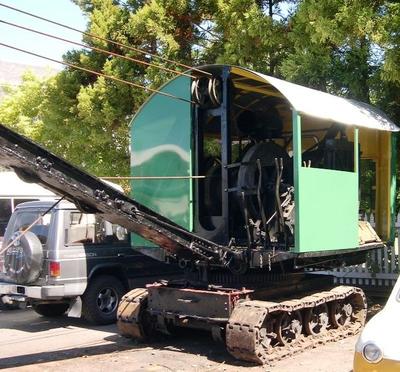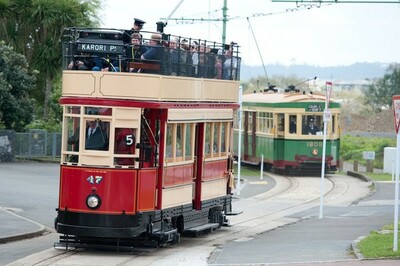Excavator [Ruston R-4]
Maker and role
Ruston-Hornsby Limited, Manufacturer
Production date
1927
See full details
Object detail
Accession number
1964.221
Maker
Production period
Description
Ruston R-4 Navvy Excavator, green cab with white, curved overhead roof. The Excavator is powered by a 4-cylinder, petrol driven Dorman engine, generating 32 HP @ 1,000 RPM. The 24" bucket at the end of the boom is controlled by a 20 mm diameter cable operated system. A long beam protrudes out the front with a shovel that acts as a digger as well as an excavator. The whole unit runs on caterpillar tracks and is capable of swivelling 360º to perform its various tasks. No.1 painted on the side of the cab. The navvy bucket is of heavy all mild steel construction, made up of steel plates, channels and angles. 3 mild steel teeth with double shear steel digging points are fitted on the outside. The bucket hinges and doors are of very strong construction.
The bottom frame is of steel construction with British section beams securely cleated together at the ends and braced by heavy corner gusset plates on the top flanges.
The tracks are of all steel construction and consist of a number of steel castings each of which forms a combined link and track pad. These castings, known as track links, are each of sufficient strength to carry the maximum wheel load. The links are connected together by 3% nickel steel pins thus forming 2 endless bands, each driven at one end by a heavy steel sprocket wheel, the intermediate links being supported on each side by 2 large diameter cast steel idler wheels carried on 2 "H" section cast steel axles, running under, and bolted to the bottom frame. Both tracks can be driven in either a forward or backward direction; and for steering, either track can be locked stationary by means of jaw clutches. The large bearing surface of the track links enables roads to be traversed without damage to the road surface.
The travelling power is transmitted from the engine through reversing dry plate clutches, friction fibre lined, and by machine-cut cast steel spur gears to the centre post shaft; thence from the bottom of the centre post shaft by machine-cut cast steel bevel wheels to a transverse shaft directly over the back axle. This transverse shaft is fitted at either end with double-ended jaw clutches which can either lock the caterpillar stationary or engage it at travelling speed. The final drive to the back axle is by machine-cut cast steel spur wheels.
The whole of the gearing on the bottom frame is totally enclosed. The machine is fitted with 2-speed travelling gear, giving slow speed for working conditions and high speed for road travelling.
The bottom frame is of steel construction with British section beams securely cleated together at the ends and braced by heavy corner gusset plates on the top flanges.
The tracks are of all steel construction and consist of a number of steel castings each of which forms a combined link and track pad. These castings, known as track links, are each of sufficient strength to carry the maximum wheel load. The links are connected together by 3% nickel steel pins thus forming 2 endless bands, each driven at one end by a heavy steel sprocket wheel, the intermediate links being supported on each side by 2 large diameter cast steel idler wheels carried on 2 "H" section cast steel axles, running under, and bolted to the bottom frame. Both tracks can be driven in either a forward or backward direction; and for steering, either track can be locked stationary by means of jaw clutches. The large bearing surface of the track links enables roads to be traversed without damage to the road surface.
The travelling power is transmitted from the engine through reversing dry plate clutches, friction fibre lined, and by machine-cut cast steel spur gears to the centre post shaft; thence from the bottom of the centre post shaft by machine-cut cast steel bevel wheels to a transverse shaft directly over the back axle. This transverse shaft is fitted at either end with double-ended jaw clutches which can either lock the caterpillar stationary or engage it at travelling speed. The final drive to the back axle is by machine-cut cast steel spur wheels.
The whole of the gearing on the bottom frame is totally enclosed. The machine is fitted with 2-speed travelling gear, giving slow speed for working conditions and high speed for road travelling.
Brief History
Ruston and Hornsby (Lincoln, Great Britain) introduced the R-4 excavator in 1926 and offered power choices between steam, electricity, petrol, or diesel. It could be ordered with several possible attachments to increase the variety of work that could be carried out by this model.
MOTAT’s excavator is petrol-powered, runs on caterpillar tracks and the cab can swivel 360 degrees on the undercarriage to expand the range of movement. The bucket’s movement is controlled by an operator in the cab who uses pedals to lift or drop the boom via a pulley system that has a strong 20mm diameter cable. Moving the boom using a pulley system enables the bucket to excavate, lift or move materials – usually for engineering purposes.
This excavator was bought by the engineering company W. Stevenson and Company (New Zealand) to take up the tram tracks between Devonport and Takapuna in 1927. Trams had not been successful on the North Shore due to less than expected patronage.
After its job on the tramlines, the excavator was used on many major projects around Auckland. These included working on American Army camp sites during World War II (1939-45) and installing gun defences on North Head in Devonport. After the War it played a major role in the construction of sewer and water lines in Mount Roskill.
One of its last major projects was the pipeline between the Cossey’s Creek Dam and Ardmore Filter Station in the 1950s. The Filter Station treats water from the Hunua Ranges. The excavator was working right up until 1964 when it was retired.
MOTAT’s excavator is petrol-powered, runs on caterpillar tracks and the cab can swivel 360 degrees on the undercarriage to expand the range of movement. The bucket’s movement is controlled by an operator in the cab who uses pedals to lift or drop the boom via a pulley system that has a strong 20mm diameter cable. Moving the boom using a pulley system enables the bucket to excavate, lift or move materials – usually for engineering purposes.
This excavator was bought by the engineering company W. Stevenson and Company (New Zealand) to take up the tram tracks between Devonport and Takapuna in 1927. Trams had not been successful on the North Shore due to less than expected patronage.
After its job on the tramlines, the excavator was used on many major projects around Auckland. These included working on American Army camp sites during World War II (1939-45) and installing gun defences on North Head in Devonport. After the War it played a major role in the construction of sewer and water lines in Mount Roskill.
One of its last major projects was the pipeline between the Cossey’s Creek Dam and Ardmore Filter Station in the 1950s. The Filter Station treats water from the Hunua Ranges. The excavator was working right up until 1964 when it was retired.
Marks
W. Stevenson & Sons Ltd. Contractors No.1 Painted
Media/Materials
Other name
Shovel - Mechanical
Backhoe
Digger
Backhoe
Digger
Collection
Credit Line
Ruston-Hornsby Limited. 1927. Excavator [Ruston R-4], 1964.221. The Museum of Transport and Technology (MOTAT).



![Our part in the Great War; Ruston-Hornsby Limited; [1919]](https://collection.motat.nz/records/images/medium/16363/a6c94c6d9aca5599a65b3ad4da9871e58ae16ee1.jpg)
Public comments
I worked for W Stevenson & Sons from 1959 to 1979 initially as an engineering cadet & then field engineer, project manager and other roles I had this machine working on a number of projects in 1959~ 1963 and have photographs of the machine on trenching and pipelaying works in Otahuhu and other locations. The Operator was Tom Majury There is ref in MOTAT records of machine & 3 men which may be one of my photos
- Ken Morris posted 2 years ago.